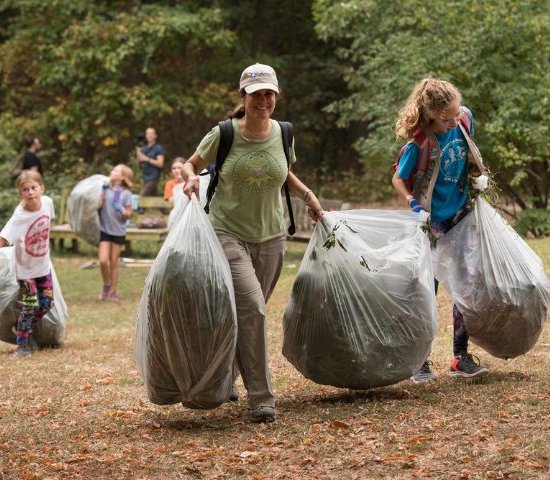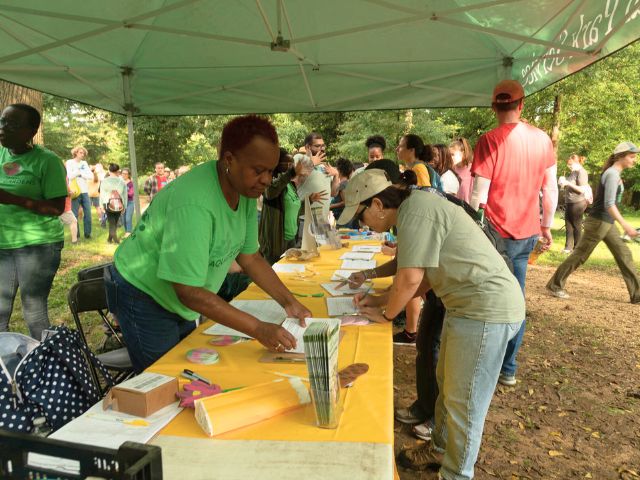
Congratulations! You've just completed a major volunteer event. Now you have some important questions to answer:
- What were you able to accomplish?
- What was your volunteer turnout like? Will those volunteers come back next time?
- If you received funding, what impact did it have on volunteer participation or conservation results?
- How can you build off the success of this year to make next year even better?
To answer these questions, you'll need to have a plan in place beforehand for collecting event metrics. Tracking event metrics helps organizations understand what does and doesn’t work at their events. By measuring things like how many volunteers showed up and what conservation goals were met, event planners can make better decisions for future events and prove their value to funders and supporters.
These measurements can show which activities people enjoyed most, help organizers spend funds wisely, and justify event costs by demonstrating real results. After each event, looking at the data reveals ways to improve an experience and set goals for the next time. This simple approach to tracking information leads to better events that achieve organizers' goals while giving attendees a great experience.

Here are key considerations when collecting metrics for an event:
Pre-Event Planning
- Check to see if there are existing systems your organization uses to store data, like organization-wide software or spreadsheets
- Define clear objectives and align with specific goals of your event or organization
- Establish if there is a baseline measurement already collected at previous events that you may need to continue collecting at your upcoming event
- Choose appropriate tracking tools and technology and determine how they integrate with existing systems (e.g., pens and clipboards, online software, etc.)
- Once you’ve selected your tools, ensure your team is trained on proper data collection processes
- Determine if there are limits or restrictions on collecting data, especially for events occurring on federal lands, which are subject to the Paperwork Reduction Act
Data Collection
- Consider if you want to capture numerical figures (quantitative data) and/or participants’ thoughts and opinions (qualitative data)
- Plan for at least two touchpoints to collect information. For example, staff collecting thoughts and feedback at the end of an event, an online survey in a post-event thank-you email, or a question at registration about how volunteers heard about your event
- Be transparent about what data you are collecting and why—participants are more likely to share information if they understand how it will help your organization
- Ensure data collection does not disrupt the event experience
- Consider offering incentives to your event attendees to participate in your surveys (e.g., gift cards, free admission to the park, etc.)
Technical Infrastructure
- Ensure reliable internet connectivity and backup systems for digital tracking tools if you plan to collect an online survey live in the field
- Test all measurement systems before the event begins and have contingency plans for technical failures
- If using on-site paper surveys, ensure there is a secure place to store them, especially if surveys ask for contact or private information
Analysis and Action
- Decide who on your team will look at which data and when they need to have results ready
- Determine how you will organize and compare your information. For example, a year-to-year comparison of event attendance or a graph charting how participants heard about an event
- Think about what you need to know right away during the event versus what you can analyze later for planning future events
- Create a simple way to share results with supporters, funders, and team members, and don’t forget to actually use what you have learned to improve your next event

The Big Picture
One service that the National Environmental Education Foundation provides as the coordinator of National Public Lands Day (NPLD) is the creation of an Impact Report. The report demonstrates to site managers and stakeholders the collective impact of how each project fits into the larger celebration of National Public Lands Day. To make sure that your hard work is counted toward the total nationwide impact, your first step should be to register your NPLD event on NEEF’s website! NEEF also asks site managers to complete an online post-event survey. Data collected includes how many participants joined the event, what NEEF resources you found helpful, and conservation outputs.
Download a printable table you can complete on the day of your event to help record your conservation outputs for the survey.
Tracking data at NPLD events demonstrates the tangible value of volunteer efforts and helps secure future funding, recruit participants, and improve event planning. This data creates a powerful narrative of nationwide stewardship that validates volunteer contributions and inspires communities. By collecting impact metrics, you showcase your volunteers' achievements while building momentum for continued participation and lasting environmental benefits.